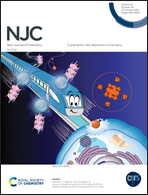A sulfonated graphene supported nano copper MoS2 network for non-enzymatic simultaneous sensing of dopamine and serotonin†
Abstract
A MoS2/SG/Cu nanocomposite was prepared by a hydrothermal method. The nanocomposites were characterized by different analytical tools. Electrochemical characterization of the composite was performed by EIS, chronoamperometry, Tafel plot, and Bode plot. The nanocomposite was coated by drop-casting over a GCE to develop a sensor electrode. The sensor electrode was used for simultaneous as well as individual electrochemical sensing of DA and 5-HT. The effect of pH, scan rate, and concentration of analytes was investigated. The influence of interfering cations (K+, Na+, Zn2+) and anions (Cl−, NO3−, SO42−) on the sensing ability of the nanocomposite was studied. The sensor electrode was also employed for the detection of DA and 5-HT in real human urine samples. A plausible mechanism of electrooxidation of DA and 5-HT has also been proposed. The sensor showed a wide linear range of 0.01 nM to 0.5 nM for DA concentrations (correlation coefficient of 0.99552) and a linear range of 0.005 nM to 0.05 nM for 5-HT concentrations (correlation coefficient of 0.99174). The limit of detection (LOD) value was calculated to be 0.85 nM for DA and 0.62 nM for 5-HT (S/N = 3). The sensor exhibited good stability in peak current potentials over a period of 30 days.



 Please wait while we load your content...
Please wait while we load your content...